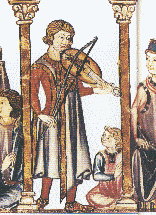Traditionally music for worship was written down, and secular music outside of worship was not. Much secular music in the early Middle Ages was improvised. However, as the era progressed, a tradition of courtly music developed.
Kings and nobles wanted entertainment, certainly, but many also wanted their courts to be known as places of culture. This led to the composition of poetry and songs that was performed in many cases by members of the court themselves rather than by itinerant minstrels. These educated musicians had different names depending on the region in which they lived and worked, but the name we most commonly associate with them is troubadour.

Introduction – Troubadours
A troubadour was a composer and performer of Old Occitan lyric poetry during the High Middle Ages (1100–1350). The troubadour school or tradition began in the late eleventh century in Occitania, but it subsequently spread into Italy and Spain. Under the influence of the troubadours, related movements sprang up throughout Europe: the Minnesinger in Germany, the trovadorismo in Galicia and Portugal, and the trouvères in northern France. The troubadours declined after the “classical” period around the turn of the thirteenth century and eventually died out around the time of the Black Death (1348).
The texts of troubadour songs deal mainly with themes of chivalry and courtly love. Many had humorous or vulgar satires. There were many genres, the most popular being the canso.
Who They Were
The 450 or so troubadours came from a variety of backgrounds. They lived and traveled in many different places, and were actors in many types of social context. Typically, they stayed in one place for a lengthy period of time under the patronage of a wealthy nobleman or woman. However, many did travel extensively, sojourning at one court and then another.
https://en.wikipedia.org/wiki/Troubadour

Status
The earliest troubadour, the Duke of Aquitaine, came from the high nobility. Many troubadours are described in their vidas as poor knights – one of the most common descriptors of their status. Later troubadours especially could belong to lower classes, ranging from the middle class of merchants and “burgers” (persons of urban standing) to tradesmen and others who worked with their hands. Many troubadours also possessed a clerical education. For some this was their springboard to composition, since their clerical education equipped them with an understanding of musical and poetic forms as well as vocal training.
Troubadours and Joglars (history)
The Occitan words trobador and trobaire are relatively rare compared with the verb trobar (compose, invent), usually applied to poetry. It signified a poem original to an author (trobador) – not merely sung or played by one. Sometime in the middle of the twelfth century a distinction was made between an inventor of original verse and the performers of others’ verse. These performers were called joglars, from the Latin ioculatores, giving rise also to the French jongleur, Castilian juglar, and English juggler, which has come to refer to a more specific breed of performer.
The medieval jongleur/joglar is really a minstrel. It is clear, for example from the poetry of Bertran de Born, that jongleurs did not usually compose.They often performed the troubadour’s songs: singing, playing instruments, dancing, and even doing acrobatics.
Trobairitz
The trobairitz were the female troubadours, the first female composers of secular music in the Western tradition. Out of a total of about 450 troubadours and 2,500 troubadour works, the trobairitz and their corpus form a minor but interesting and informative portion.
The trobairitz were in most respects as varied a lot as their male counterparts, with the general exceptions of their poetic style and their provenance. Only two have left us more than one piece: the Comtessa de Dia, with four, and Castelloza, with three or four.
- Authored by: Elliott Jones. Provided by: Santa Ana College. Located at: http://www.sac.edu. License: CC BY: Attribution
- Troubadour. Provided by: Wikipedia. Located at: http://en.wikipedia.org/wiki/Troubadour. License: CC BY-SA: Attribution-ShareAlike
Countess of Dia
Our listening example from the troubadour tradition comes from the most famous of the female troubadors (trobairitz). The Comtessa de Dia, probably named Beatritz or Beatriz (fl. c. 1175), is only known as the comtessa de Dia in contemporary documents. Her poems were often set to the music of a flute.
A chantar m’er de so qu’eu no volria in the Occitan language (video performance below ) is the only canso by a trobairitz to survive with its music intact. Countess of Dia’s typical subject matter includes optimism, praise of herself and her love, as well as betrayal. The Countess plays the part of a betrayed lover, and despite the fact she has been betrayed, continues to defend and praise herself. Her writing style, uses a process known as coblas ingulars in A chantar, – repeating the same rhyme scheme in each strophe, but changing the a rhyme each time. Note that this work is not in a major or minor mode but one of the other modes characteristic of this time.
Listen: A chantar m’er
The only existing song by a trobairitz that survives with music.
Below is a very rhythmical melodic La Dousa Votz by Bernard Ventadorm. Go to this link for more information (including text and translation plus beautiful illustrations text and translation and more information La dousa Votz. and the composer – http://toddtarantino.com/hum/ventadorn.html
CC LICENSED CONTENT, ORIGINAL
Authored by: Elliott Jones. Provided by: Santa Ana College. Located at: http://www.sac.edu. License: CC BY: Attribution
CC LICENSED CONTENT, SHARED PREVIOUSLY
Beatritz de Dia. Provided by: Wikipedia . Located at: http://en.wikipedia.org/wiki/Beatritz_de_Dia. License: CC BY-SA: Attribution-ShareAlike
